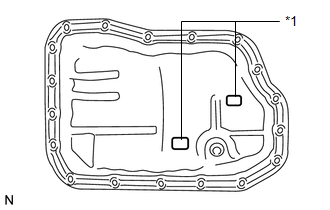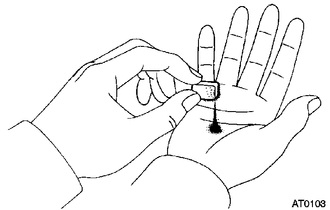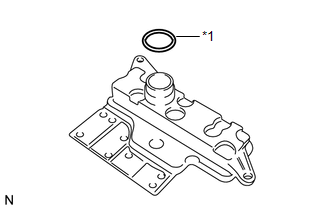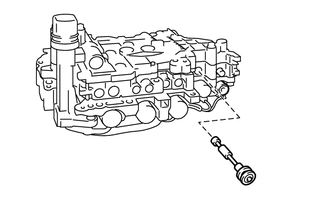Toyota Venza: Removal
REMOVAL
PROCEDURE
1. REMOVE AUTOMATIC TRANSAXLE ASSEMBLY
HINT:
See the steps from "Remove Engine Assembly with transaxle" through "Remove Automatic
Transaxle Assembly" (See page .gif) ).
).
2. REMOVE AUTOMATIC TRANSAXLE OIL PAN SUB-ASSEMBLY
|
(a) Remove the 18 bolts and automatic transaxle oil pan sub-assembly from the automatic transaxle assembly. NOTICE: Some fluid will remain in the automatic transaxle oil pan sub-assembly. Remove all the bolts, and carefully remove the automatic transaxle oil pan sub-assembly. |
|
(b) Remove the automatic transaxle oil pan gasket from the automatic transaxle oil pan sub-assembly.
|
(c) Remove the 2 transmission oil cleaner magnets from the automatic transaxle oil pan sub-assembly. Text in Illustration
|
|
|
(d) Examine particles in the automatic transaxle oil pan sub-assembly. (1) Use the removed transmission oil cleaner magnets to collect any steel chips. Examine the chips and particles in the automatic transaxle oil pan sub-assembly and on the transmission oil cleaner magnets to determine what type of wear has occurred in the automatic transaxle assembly: Result: Steel (magnetic) Bearing, gear and plate wear Brass (non-magnetic) Bushing wear |
|
3. REMOVE VALVE BODY OIL STRAINER ASSEMBLY
|
(a) Remove the 2 bolts and valve body oil strainer assembly from the transmission valve body assembly. |
|
|
(b) Remove the O-ring from the valve body oil strainer assembly. Text in Illustration
|
|
4. REMOVE TRANSMISSION VALVE BODY ASSEMBLY
|
(a) Remove the 11 bolts and transmission valve body assembly from the automatic transaxle assembly. NOTICE: When removing the transmission valve body assembly, be careful not to allow the speed sensor and the automatic transaxle assembly to interfere with each other. |
|
5. REMOVE MANUAL VALVE
|
(a) Remove the manual valve from the transmission valve body assembly. |
|
 Disassembly
Disassembly
DISASSEMBLY
PROCEDURE
1. REMOVE TRANSMISSION WIRE
2. REMOVE ATF TEMPERATURE SENSOR ASSEMBLY
(a) Remove the 4 bolts, ATF temperature sensor assembly and clamp from
the valve body ...
 Inspection
Inspection
INSPECTION
PROCEDURE
1. INSPECT SHIFT SOLENOID VALVE SL
(a) Measure the resistance according to the value(s) in the table below.
Text in Illustration
*1
...
Other materials about Toyota Venza:
CD Sound Skips
PROCEDURE
1.
CHECK CD
(a) Check that the CD is not deformed or cracked.
OK:
No deformation or cracks on the CD
NG
END (CD IS FAULTY)
...
Removal
REMOVAL
CAUTION / NOTICE / HINT
CAUTION:
Some of these service operations affect the SRS airbag system. Read the precautionary
notices concerning the SRS airbag system before servicing (See page
).
NOTICE:
Be sure to read "Precaution" thorou ...
Installation
INSTALLATION
PROCEDURE
1. INSTALL LUMBAR SUPPORT ADJUSTER ASSEMBLY
(a) Install the bush.
(b) Install the lumbar support adjuster assembly with the guide and 2
screws.
...
0.1294

.png)


.png)

.png)
